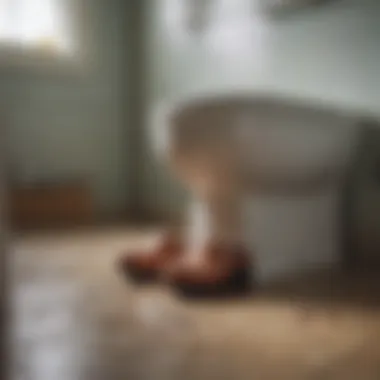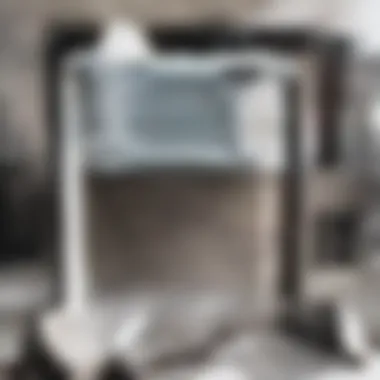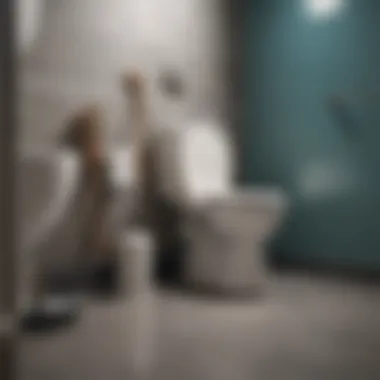Understanding Toilet Clogs: Causes and Solutions


Intro
As homeowners, we seldom give much thought to our toilets until an unexpected clog interrupts our daily routines. Toilet clogs can be more than a nuisance; they represent a variety of underlying issues that may suggest deeper problems within our plumbing systems. To grasp the full scope of this problem, we must first explore the intricate reasons behind these clogs and understand their implications.
This guide serves to highlight significant insights on toilet clogs, throwing light on structural troubles, material obstructions, and improper usage. Furthermore, we will offer practical maintenance and prevention strategies that can save homeowners from headaches caused by unexpected plumbing failures.
By comprehensively looking into the causes, readers can empower themselves with practical knowledge. Equipped with this understanding, they can navigate potential clogs, maintain their toilets effectively, and create an environment free of plumbing worries. A proactive approach not only saves time but also ensures that our bathrooms remain functional and serene.
Common Causes of Toilet Clogs
Structural Issues
Toilet clogs can stem from structural issues within the plumbing system. An improperly installed toilet can lead to flaws affecting drainage. Large bends or tight angles in the pipes might trap waste and toilet paper, causing backups over time. Evaluating these elements is key.
- Old Pipes: Corroded or aged materials can also restrict flow and lead to blockages.
- Improper Pitch: The sloping of pipes must direct waste efficiently. A flat or upward slope can halt the flow.
Material Blockages
Trash and foreign objects often lead to clogs. Misuse of the toilet is a significant contributor. Items like wipes, hygiene products, or excessive toilet paper should not be flushed. Identifying these materials is crucial for resolving ongoing issues.
- Grease and Oil: Even food remnants that make their way through drains can solidify and cause issues downstream.
- Hair and Fibers: Long hair can intertwine with other substances and create blockage points.
Incorrect Usage
User habits play an essential role in the frequency and severity of toilet clogs. Understanding what goes down the toilet is necessary. Education on proper usage can prevent many clogged toilet scenarios.
- Flushing Non-Biodegradables: Toilets should be used correctly, disposing of only waste and toilet paper.
- Overloading: Flushing large amounts of materials at once can overwhelm the toilet’s drainage system.
Preventive Measures
Implementing preventive measures is key to prolonging the life of your toilet and reducing the risk of clogs.
- Regular Maintenance: Routine checks can help identify potential issues. Cleaning the internal mechanisms and checking water flow can preempt problems.
- Educating Household Members: Teaching all users about what should and should not be flushed can significantly reduce misuse.
- Using Enzyme Cleaners: These products break down waste accumulation within pipes, contributing to smoother operation.
"Regularly maintaining your toilet not only prolongs its lifespan but also offers peace of mind."
The End
Toilets are essential in our lives, yet often taken for granted. Understanding the complex reasons behind clogs fosters a proactive stance toward plumbing maintenance. By knowing what causes obstructions, homeowners can minimize disruptions. Simple adjustments in habits and proactive care can lead to smoother flows and a more pleasant bathroom experience.
Through this guide, readers aimed to become more aware and prepared against clogs. The insights shared enable them to solve issues before they escalate, ensuring the functionality of one of the most critical fixtures in any home.
Preface to Toilet Clogs
Toilet clogs are a common household nuisance that often lead to frustration and inconvenience. Understanding the topic of toilet clogs is essential for not just homeowners, but also for renters and anyone responsible for maintaining a property. When toilets do not flush properly, it signals an underlying issue that could escalate into more significant plumbing problems if left unattended.
The importance of addressing this topic lies in its multifaceted nature. There are many contributors to clogged toilets, including improper usage, structural constraints, and a lack of preventative maintenance. By gaining insights into these causes, one can take proactive steps to avoid clogs altogether. This knowledge serves as a resource for readers to recognize early warning signs of clogs and implement appropriate measures before a minor inconvenience spirals into an emergency, requiring urgent attention.
Additionally, understanding toilet clogs promotes informed decision-making about maintenance and repairs. Homeowners can save time and minimize costs by addressing issues promptly rather than waiting for them to worsen. Whether the problem stems from excessive toilet paper usage or more complex plumbing issues, being well-informed on the matter equips the reader with the tools to handle these situations effectively.
In sum, this section paves the way for deeper exploration into the specific causes of toilet clogs and offers practical guidelines to maintain efficient and functional plumbing systems.


Common Causes of Toilet Clogs
Understanding the common causes of toilet clogs is crucial for both homeowners and renters alike. By identifying these problems early, individuals can take proactive measures to prevent clogs from developing into more serious issues. A clog not only disrupts daily routines but can also lead to costly repairs and health hazards. Recognizing what typically leads to toilet clogs enables better usage and maintenance practices, ensuring a smoother operation of this essential household fixture.
Excessive Toilet Paper Use
One of the leading causes of toilet clogs is the excessive use of toilet paper. While toilet paper is designed to break down in water, using too much at once can overwhelm the toilet's flushing system. This becomes particularly problematic in older toilets or those with less powerful flush mechanisms.
To minimize the risk of clogs, users should consider limiting the amount of toilet paper used in each flush. It is recommended to use one or two squares at a time, especially for those prone to clogs. For reference, some toilet papers dissolve better than others; thus, choosing a brand that claims to be septic-safe can also prove beneficial.
Foreign Objects in the Bowl
Foreign objects in the toilet bowl represent another significant cause of clogs. Items like toys, sanitary products, or even small household debris can mistakenly end up in the bowl. Once flushed, these solid objects can block pipes, leading to backups.
To avoid this issue, it is important to educate all users, especially children, about what is permissible to flush. Additionally, placing a trash can within easy reach can help reduce the likelihood of inappropriate flushing.
Clogged S-Trap
A clogged S-trap can lead to significant toilet clogs as well. The S-trap is a curved pipe that connects the toilet to the sewer line. Its design is meant to trap water, preventing sewer gases from entering the home. However, buildup of waste or flushable products can create obstructions that reduce flow. Regularly inspecting and maintaining the trap can help prevent blockages.
Blocked Vent Stack
The vent stack plays an important role in maintaining pressure and airflow within the plumbing system. If this stack is blocked—be it by debris, bird nests, or other materials—airflow becomes restricted. This restriction can lead to improper flushing and subsequent overflows or clogs.
To ensure proper ventilation, homeowners should routinely check the vent stack from the roof for any signs of blockages. If a blockage is identified, it may be necessary to remove it to restore full function.
Old Plumbing Systems
Lastly, old plumbing systems often contribute to toilet clogs. Aging pipes are more susceptible to corrosion and buildup from years of mineral accumulation, which can further narrow plumbing passages and facilitate clogs. If your home has older plumbing, consider periodic inspections by a qualified plumber. They can provide insights into areas that may need replacing or cleaning, ultimately protecting against future clogs.
Understanding these common causes of toilet clogs gives readers valuable knowledge to tackle such issues proactively and effectively. Through better awareness and preventative measures, maintaining a functioning toilet will become a simpler task.
Diagnosing the Problem
Diagnosing the problem of a clogged toilet is a crucial step in addressing plumbing issues effectively. Understanding how to identify clogs promptly can prevent larger complications down the line. It allows homeowners to determine the severity of the issue and decide on the best course of action. Recognizing the signs of a clog, as well as knowing how to use tools like a plunger, can save time and money. Additionally, early diagnosis can minimize health risks associated with untreated clogs.
Signs of a Clog
Several indications can help you recognize if your toilet is clogged. Here are some of the signss to look out for:
- Slow Drainage: If the toilet takes longer than usual to empty after flushing, this could signal a clog.
- Gurgling Noises: Unusual sounds from the toilet bowl may suggest air bubbles trapped in the plumbing due to a blockage.
- Overflowing: If the toilet overflows when flushed, it is a clear sign of a serious clog that needs immediate attention.
- Back Flow: Water rising in the bowl after flushing usually indicates a block in the plumbing system.
- Stubborn Blockages: Frequent need for plunging is a strong indicator of an underlying issue.
Recognizing these symptoms promptly can prevent further complications and costly repairs.
Using a Plunger Effectively
Using a plunger can be an effective method for clearing common toilet clogs. However, not everyone knows how to use this simple tool properly. Here are some steps to ensure effective use:
- Choose the Right Plunger: A toilet plunger typically has a flanged end, designed to create a better seal in the toilet bowl.
- Position the Plunger: Place the plunger into the toilet bowl, ensuring it covers the drain completely. The flanged part should fit snugly into the drain opening.
- Create a Seal: Push down slowly to create a seal and then pull up sharply. Repeat the process quickly without lifting the plunger out of the bowl, which could break the seal.
- Use Water as Assistance: If the bowl is empty, add some water to help create more suction. This may enhance the effectiveness of the plunger.
- Flush: After several vigorous pumps, flush the toilet to see if the clog has cleared.
Using a plunger effectively can resolve minor clogs without the need for professional assistance. However, if problems persist despite these efforts, it may be time to explore further solutions.


Implications of a Clogged Toilet
Understanding the implications of a clogged toilet is essential for homeowners and renters alike. When a toilet fails to flush properly, the immediate consequences can lead to discomfort and inconvenience. However, the implications extend beyond mere annoyance. It poses significant health risks, potential damage to plumbing systems, and can even affect the overall hygiene within the living environment. A thorough exploration of these factors can help in taking preventive measures and prompt actions towards a safer and more efficient plumbing system.
Health Risks of Untreated Clogs
When toilets clog and are left unattended, they can become breeding grounds for harmful bacteria. Waste buildup can lead to the proliferation of pathogens such as E. coli and Salmonella, which may cause serious gastroenteritis and other digestive issues. Here are some specific health concerns:
- Bacterial Infections: Prolonged exposure to untreated waste can introduce infections not only to the individual using the toilet but also to other residents in the household.
- Air Quality: Clogs can lead to unpleasant odors that may affect indoor air quality. Continuous exposure to these odors can lead to respiratory issues and overall discomfort.
- Mold Growth: Excess moisture caused by overflows can contribute to mold growth, which is another health hazard. Mold can aggravate allergies and respiratory conditions.
In essence, neglecting to address a clogged toilet may allow potential health hazards to fester, making prompt attention essential.
Potential Damage to Plumbing Systems
A clogged toilet does not only affect its immediate use; it can also cause considerable damage to the plumbing system over time. Here are key points to consider regarding plumbing systems:
- Pipe Damage: Persistent clogs can lead to increased pressure in the pipes. This may cause leaks, cracks, or even complete pipe failure.
- Sewage Backup: Severe clogs can result in sewage backing up into the home, creating not only a health hazard but also a costly cleanup effort. This may require professional intervention, which can be expensive.
- Increased Repair Costs: The longer a problem persists, the more costly the repairs will become. Regular maintenance can prevent minor issues from escalating into major ones, which is often more affordable in the long run.
As homeowners, it is crucial to be aware that a seemingly minor issue like a clogged toilet could lead to extensive damage and health concerns.
Preemptive action and timely repair measures should be a priority for all homeowners. Understanding these implications not only emphasizes the importance of immediate attention to clogs but also promotes a proactive approach toward plumbing maintenance.
Preventive Measures
Preventive measures serve as the first line of defense against the recurring issue of toilet clogs. By understanding the importance of proper usage and maintenance, homeowners can greatly reduce the likelihood of clogs developing. This section will delve into specific techniques for using toilets effectively and outline regular practices that can prolong the life of plumbing systems, thereby minimizing potential issues.
Proper Usage Techniques
Proper usage techniques are essential for ensuring that toilets function efficiently. Here are some important elements to consider:
- Limit Toilet Paper Use: Using excessive amounts of toilet paper can easily lead to clogs. It is recommended to use only what is necessary. Consider keeping a small wastebasket nearby for items that should not be flushed.
- Avoid Flushing Foreign Objects: Items such as wipes, cotton balls, or hygiene products should never be flushed. These objects do not break down like toilet paper and can quickly create a blockage in the plumbing.
- Educate Family Members: Awareness is key. Make sure everyone in the household understands what can and cannot be flushed. This includes teaching children about the appropriate use of the toilet.
By following these usage techniques, one can significantly decrease the risk of a future clog.
Regular Maintenance Practices
Regular maintenance practices can further enhance the functionality of your toilet. These involve both proactive and reactive strategies:
- Routine Inspections: Check for leaks or cracks periodically. Small issues can escalate into larger problems if not addressed promptly.
- Use Enzyme-Based Cleaners: Enzyme-based cleaners can help break down materials that may lead to clogs. They are usually safer for plumbing than harsh chemicals.
- Flush with Care: It may be wise to flush only when necessary. Excessive flushing can disturb the balance of the plumbing system, particularly if the toilet is older.
- Professional Check-Ups: Scheduling regular inspections with a plumber can identify potential problems before they escalate. It is advisable to do this annually or biannually.
Adopting these regular maintenance habits can ensure that toilets remain functional and reduce the need for extensive repairs in the future.
DIY Solutions for Unclogging
When faced with a clogged toilet, many homeowners seek immediate and effective remedies before resorting to professional help. Understanding how to effectively use DIY solutions for unclogging can save time and expense. These methods often require common household items, making them accessible and practical. Moreover, implementing these approaches can help prevent further issues related to clogs in the future.
Real estate enthusiasts and interior design aficionados will appreciate the simplicity and functionality of these techniques in maintaining a well-functioning household. Thus, the importance of DIY solutions in this context cannot be overstated.
Homemade Drain Cleaners
Homemade drain cleaners are a popular choice for tackling minor clogs. These solutions are often made from ingredients that are both effective and safe for plumbing systems. Here's how to create a simple yet effective homemade drain cleaner:


- Baking Soda and Vinegar: This combination forms a powerful effervescent reaction that can dislodge mild clogs.
- Salt and Baking Soda: This mix can help break down debris and eliminate odors.
- Hot Water: Sometimes, just using hot water can clear a clog.
- Steps: Pour a cup of baking soda down the toilet, followed by a cup of vinegar. Allow the mixture to sit for 30 minutes before flushing with hot water.
- Steps: Combine half a cup of salt with half a cup of baking soda and pour it into the toilet bowl. Let it sit for several hours or overnight, then flush with hot water.
- Steps: Boil a large pot of water and pour it carefully into the bowl from waist height. The force and heat can help dissolve clogs.
These homemade cleaners are not only cost-effective, but they also minimize the risk of introducing harsh chemicals into your plumbing system. However, it’s important to note that these methods may not work for severe blockages, which could require more advanced techniques.
Accurate Use of a Toilet Auger
A toilet auger is a specialized tool designed to navigate the bends of a toilet's plumbing with efficacy. Using a toilet auger accurately is essential for successful unclogging. Here’s how to properly use this tool:
- Insert the Auger: Begin by removing any excess water from the bowl. Insert the end of the auger into the toilet bowl until it reaches the clog.
- Crank the Handle: Once the auger is positioned properly, crank the handle clockwise. This action allows the flexible cable to extend and sweep through the pipe. It can help break up or retrieve the obstruction.
- Feel for Resistance: If you encounter resistance while cranking, this indicates you have reached the clog. Gently push and pull to break it apart or pull it out.
- Clean and Flush: After successfully dislodging the clog, remove the auger carefully. Flush the toilet to ensure that all remnants are cleared away.
The accurate use of a toilet auger can save significant time compared to traditional plunging methods. It’s a practical solution for more stubborn blockages. Keep in mind that improper use can lead to damage, so take care to follow the instructions closely.
Remember: DIY solutions are effective for many clogs but knowing when to call for professional help is equally important. Persistent issues may indicate underlying plumbing problems that require expert assessment.
When to Call a Professional
Understanding when to call a professional is crucial for effectively managing a clogged toilet situation. While many clogs can be resolved with DIY methods, there are instances when enlisting the help of a qualified plumber becomes essential. A professional can provide expertise, access to specialized tools, and a thorough assessment of your plumbing system's health. Here, we will explore two vital aspects of this topic: identifying persistent issues and understanding the costs involved.
Identifying Persistent Issues
Detecting persistent issues is an important skill for homeowners. Not every clog is created equal, and chronic problems often signal deeper issues with the plumbing system.
Some key indicators that you need to seek professional assistance include:
- Frequent Clogging: If your toilet frequently clogs, even after using plungers or other remedies, there may be a blockage in the plumbing system beyond the immediate toilet.
- Unusual Noises: Gurgling sounds from the toilet or nearby drains can indicate vent stack problems or trapped air, suggesting a need for a professional evaluation.
- Slow Drains: Consistently slow drains across multiple fixtures often indicate a greater issue, potentially involving the house’s main sewer line.
- Foul Odors: Persistent rancid smells suggest decay or sewage buildup, which is a clear signal to call in an expert.
Prolonging DIY attempts in the presence of these signs can worsen the situation, potentially leading to extensive damage and costly repairs.
Understanding the Costs Involved
When considering whether to employ a professional for a clogged toilet, understanding the associated costs is vital. Several contributing factors dictate the expense:
- Service Fees: Plumbers typically charge a service fee for assessments, often ranging from $50 to $150. This covers their time and expertise.
- Repair Costs: Depending on the issue, repairs can be minimal, such as removing a blockage, or extensive, like replacing pipes. Repair costs can vary greatly.
- Urgent Service Charges: If you need emergency plumbing services, expect an elevated cost. Late-night or holiday calls can incur significantly higher fees.
- Potential for Preventive Work: In cases where the clog stems from regular maintenance issues, investing in a professional might include recommendations for future preventive measures, saving you costs down the line.
Even though it may seem tempting to tackle everything yourself, recognizing when to tap into professional expertise can save both time and money in the long run. In situations of persistent clogging, the reality is that sometimes a trained plumber is the best bet for a lasting solution.
Finale
The conclusion serves as an essential component of this article, synthesizing the main themes and insights about toilet clogs. It highlights the significance of understanding the multifaceted reasons behind these plumbing issues. Recognizing the causes, implications, and preventative measures discussed throughout the article can empower homeowners and renters alike. This knowledge not only fosters better maintenance practices but also helps in avoiding the inconveniences that come with toilet clogs.
A toilet clog is often more than just an inconvenience. It can indicate larger problems in your plumbing system. Therefore, being equipped with the right information is crucial for effective home management. Here are some specific elements to consider:
- Understanding Causes: Knowing what leads to clogs is vital. This includes excessive use of toilet paper, foreign objects, and issues with plumbing systems.
- Health and Safety Risks: Unaddressed clogs can pose health risks. A clogged toilet is not just a plumbing issue; it can also become a health hazard over time.
- Preventative Practices: Regular maintenance practices can save homeowners from future troubles. Incorporating simple habits in daily usage can significantly reduce the chances of clogs occurring.
Recap of Key Points
In summary, our exploration of toilet clogs has unveiled several critical elements:
- Key Causes: Excessive toilet paper, foreign objects, and plumbing issues are primary contributors to clogs.
- Signs of Issues: Recognizing early signs of a clog can lead to more successful interventions before the issue escalates.
- DIY Solutions: Simple solutions like using a plunger or homemade drain cleaners can be effective in managing minor clogs.
- When to Seek Help: Distinguishing between minor clogs and more serious plumbing issues is necessary for timely professional assistance.
- Preventative Measures: Implementing good practices in toilet use and routine maintenance can mitigate future problems.
By grasping these concepts, readers will not only be equipped to manage existing clogs but also to prevent future occurrences effectively. This knowledge enhances the overall integrity of household plumbing, ultimately facilitating a more enjoyable living experience.







